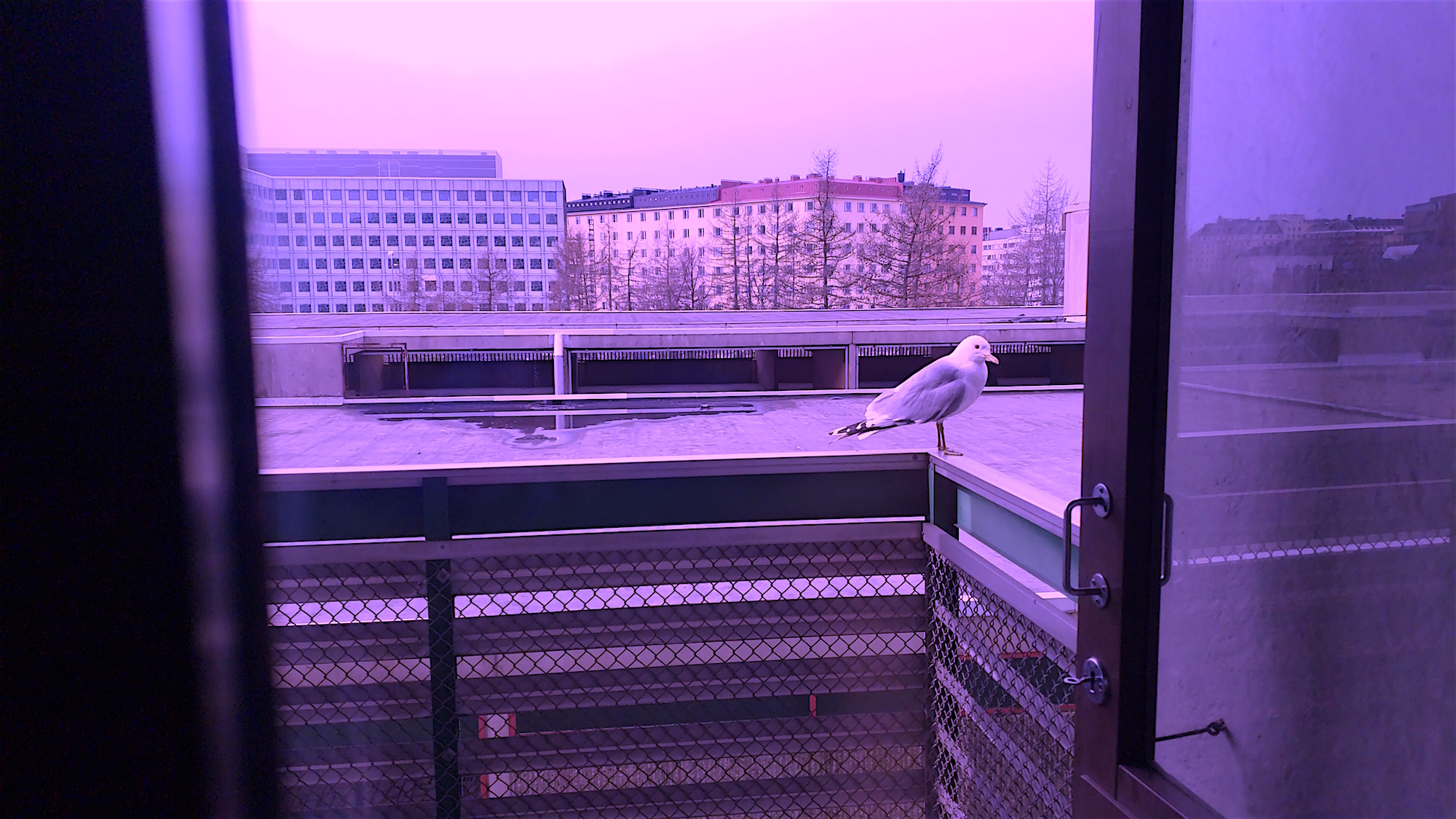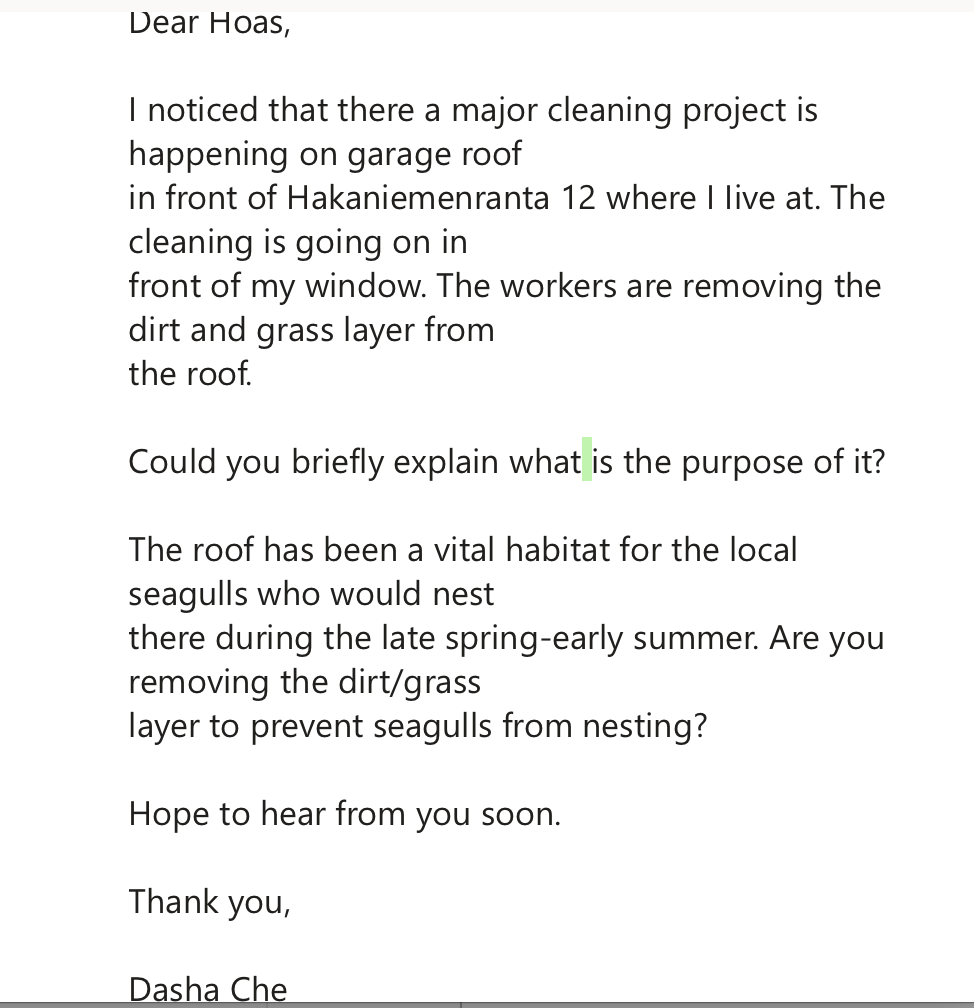a short story of one gentrification
1)
In this artistic research work, I situate the body and other objects of care within the public narratives of economic migration or displacement caused by the local, national and international capital flow, whether social, cultural or financial. When construing this network I bring and blur trans-local (located in multiple places in an ongoing conversation with and relationality to each other) and hyper-local (located right here in the immediate surroundings) in my inquiry. I am interested in uncovering the corporeal and linguistic connections and its affects to the surrounding and (un)familiar objects that encounter each other in this ongoing migration.
* * *
(a short breath)
* * *
I invite economic migration in its widest definition as one of the ontological places for this research. To locate my body on the canvas of the global narratives of economic displacement, first I focus on the narratives of my family, specifically on my mother’s. My mother was born in Magnitogorsk, a Soviet industrial city in Ural mountains modeled after its American counterpart in Gary, Indiana in 1929. Stalin’s dream of an industrial giant, it became one of the largest steel plants in the world. My grandparents moved to Magnitogorsk as a young workforce soon after the WWII, met at the plant and started the family. Same as her older sister, my mother studied to be a preschool teacher at the pedagogical college of Magnitogorsk in the 1970s. As a Soviet economic policy most of the young graduates were sent to any work place in any Soviet republic where the new workers were needed at that moment. Most of the displaced bodies, such as my mother’s, had no say in this process. My mother was sent to the city of Izhevsk the capital of Udmurt Republic - a random location that I was born at and started calling home. Similarly, the rest of the places through which the bodies displaced and orchestrated by economic migration pass through are as random as this one for me. Therefore, randomness, chance, external decisive forces, and all the risks affiliated with that, are the ever-flickering guidance lights in my research.
* * *
risk taking
the flow of capital and monetized objects
ongoing economic migration
2)
(one breath in and a slightly longer breath out)
* * *
After the Soviet collapsed in 1991, now disjointed post-Soviet countries entered a new economic model, a capitalist market system built on the ruins of Soviet economies. Poverty and instability of the 1990s led to a mass economic fleeing. The post-Soviet people orientated themselves toward the West (Western Europe and USA) as an ideal of a safer and a more stable living. Some of those who did not have the financial, professional or social means needed for migration, sought help of the internet bridal agencies - looking for a European or an American husband. My mother started to develop her economic migration plan when I was 12 and moved to the United States as a bride when I was 18. I followed her at the age of 19. While, I can point these dates as the official beginning of my personal economic migration, the migration imaginary or the desires extending toward better and safer living conditions elsewhere, lingered in our lives since much earlier. The encounters with multiple desired objects also exported from elsewhere and gleaming in the horizon such as English language, jeans, the color of pink, images of attractive and healthy bodies, teeth and smile, human rights, gay love, tasty foods, vast open spaces of monumental natural sites persisted throughout my entire family life.
Here I would like to break my family story line in order to bring the attention to the second narrative of a different economic displacement that enters into the communication with the first one. About this time a year ago Helsinki seagulls arrived to the 2-storied garage roof behind the Merihaka's Hakaniemenranta 12 apartment building. They began to nest on the mossy vegetation covering the roof. Confined to my room during the beginning of the pandemic in 2020, I observed seagulls’ life closely, as they courted, fucked, laid eggs and raised their offspring. Around mid-summer, the babies grew and flew away, and seagulls left the roof for the year. This spring when the first seagull couples began to inhabit the roof again - as their annual practice - the apartment complex administration started the act of gentrification, a cleaning the roof project that removed the soil and moss layer - the vital seagulls’ habitat. Only a few seagull couples remained on the bare concrete roof choosing a more hidden places to nest and bringing the sticks and grass with them to rebuild their homes. A feature of late capitalism, gentrification is an elaborate multi-layered economic profit-driven process which extends into and intertwines with corporeal time and living in a way that can both go unnoticed for quite a while or be straightforward and evident as with the seagulls. All gentrification practices focus on the displacement of unwanted bodies to remodel their former habitats so it yields more profit. Human gentrification is usually a much slower process that the urban animals' removal.
Gentrification was on its way in the Mission District of San Francisco when I moved into International Guest House on Harrison and 23rd Street, one of the last cheap hostels in the neighborhood. I stayed in the Mission District for ten years migrating from one cheap house to another following the network shared by artists and immigrants many of whom were trying to hold on to the neighborhood that was rapidly changing. People who resided in the Mission for decades could not afford to live there any longer. I was in a role of a gentrifier, as a young white artist, and a gentrified, as an undocumented immigrant.
* * *
(open jaw)
* * *

migration imaginary
3)
* * *
(open jaw)
* * *
G E N T R I F I C A T I O N -->
First, the run-down poor, often racialized neighborhood attracts local artists, underground and alternative communities for cheap rent and new artistic opportunities. Then, it becomes a popular destination for the wealthier locals and tourists, which brings in urban developers that slowly remove the original inhabitants’ livelihood resources, such as affordable rent and services, like the construction workers removed seagulls’ habitat from the roof.
* * *
(open jaw and a soft tongue)
* * *
And here I circle back to the first story, exploring the connections it has with the second one for me. After fourteen years of absence I return back to Russia and find it familiar but do not recognize. A few seagulls continue to linger on the bare roof persisting, maintaining a connection with home that was changed. The strangeness I encounter in the familiar is unsettling, still a certain new intimacy emerges through turning toward this strangeness.
How does this intimacy with strangeness emerges and bonds different bodies? How does this new estranged intimacy turn all the bodies participating into the objects of care, thus the objects that emit care despite the strangeness? How do the objects to care come around in the midst of foreignness and generate care bonds in the place of unrecognition?
* * *

TO GO HOME
CLICK HERE
!!! IN THE WORKS: to find a comfortable distance from the personal chronological narratives and bring in the concepts related to economic migration closer to my current artistic research of foreignness in language and body
!!! IN THE WORKS: to further understand the role of economic fictioning
in my artistic research